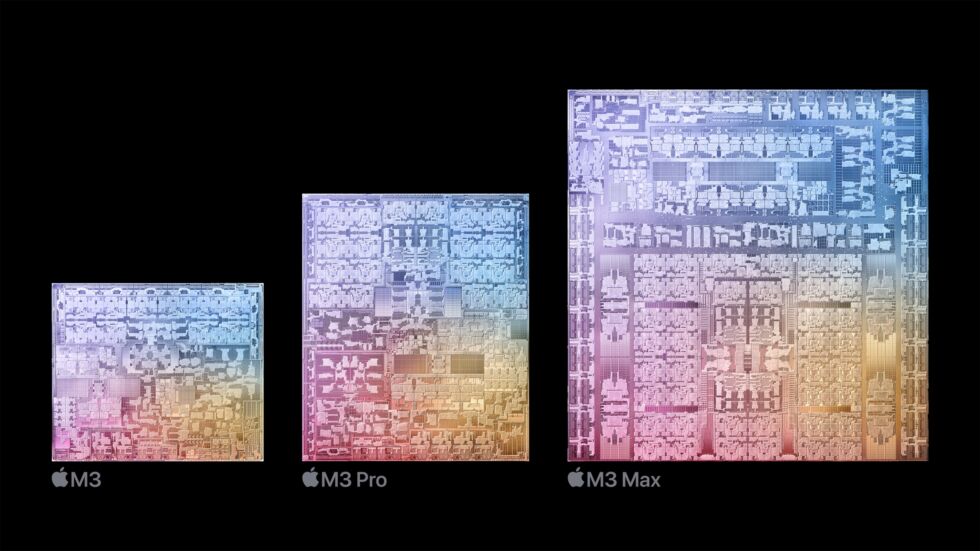Overview M3 Series
The Apple M3 series, including the standard M3, the more powerful M3 Pro, and the top-tier M3 Max, represents a significant leap in Apple’s processor technology. In addition to enhancing CPU and GPU performance to unprecedented levels, this new SoC is designed to set new records for transistors in a single laptop SoC built on TSMC’s 3nm N3B process.
M3 Series Range
M3 Designed for general use and efficiency, the standard M3 offers an 8-core CPU and a 10-core GPU, offering up to 24GB of unified memory.
M3 Pro To meet the demands of more demanding users, the M3 Pro features a 12-core CPU, 18-core GPU, and 36GB of memory.
M3 Max With its 16-core CPU and 40-core GPU, along with up to 128GB of RAM, the M3 Max pushes the limits of professional workstations.

The M3 series of chips from Apple has improved performance over their predecessors in several ways. In addition to improving power efficiency, the M3 chips deliver the same performance as the previous generation at half the power, and the CPU is equally efficient. Compared to a 12-core Intel Core i7-1360P, the M3 chips require only a quarter of the energy to perform.
Several video codecs, including H.264, HEVC, ProRes, and ProRes RAW, are supported by the M3 family’s dedicated media engine. As well as releasing the M3 series, Apple has also updated its MacBook Pros and 24-inch iMacs with the new chips. As Apple’s strategy for high-performance silicon for Macs and high-end iPads has changed, the M3 Pro represents a significant change from its predecessor.
The M3 series marks a significant milestone in Mac technology, introducing the incorporation of hardware-accelerated ray tracing. This advancement enables the generation of lifelike and precise images by simulating how light behaves within a given scene. This feature is especially beneficial for professional use and gaming, as it allows for the creation of immersive environments with realistic shadows and reflections. Additionally, the M3 series also boasts hardware-accelerated mesh shading, bolstering its capabilities for handling complex geometry in graphics-intensive tasks and games.
With Dynamic Caching, local memory is allocated in real time in the M3 chips, so each task uses only what is needed. In addition to dramatically increasing GPU utilization, this innovation significantly improves performance for demanding professional applications and games.

The M3 family features a next-generation GPU architecture that consumes nearly half the power of the M1, while delivering the same performance. This means that the M3 GPU can deliver up to 65% more performance at peak performance. The improved GPU architecture enables more detailed and immersive game environments, making it great for graphics-intensive fields like 3D rendering, graphic design, and video production.
Next-generation GPU architecture in the M3 family consumes half the power of the M1, but delivers the same performance. This means the M3 GPU can deliver up to 65% more performance at peak. As a result of the enhanced GPU architecture, games are more detailed and immersive, which makes it ideal for graphic design, video production, and 3D rendering.
Its M3 CPUs deliver enhanced performance while maintaining power efficiency. CPU performance cores are 30% faster than the M1 and 15% faster than the M2, while efficiency cores are 50% faster than the M1 and 30% faster than the M2. The result is faster and more responsive computing for everyday users, whether they are browsing the web or editing multimedia.
With a unified memory architecture, the M3 series delivers high bandwidth, low latency, and power efficiency. With this architecture, data is not copied across multiple memory pools, so all technologies within the chip can access the same memory pool. Thus, tasks are performed more efficiently while using fewer resources.
This 16-core Neural Engine handles complex and sophisticated AI applications such as pattern recognition and predictive analytics 60% faster than the M1 and 15% faster than the M2. It is particularly useful for tasks requiring extensive data analysis and real-time processing, such as advanced speech and image recognition.

